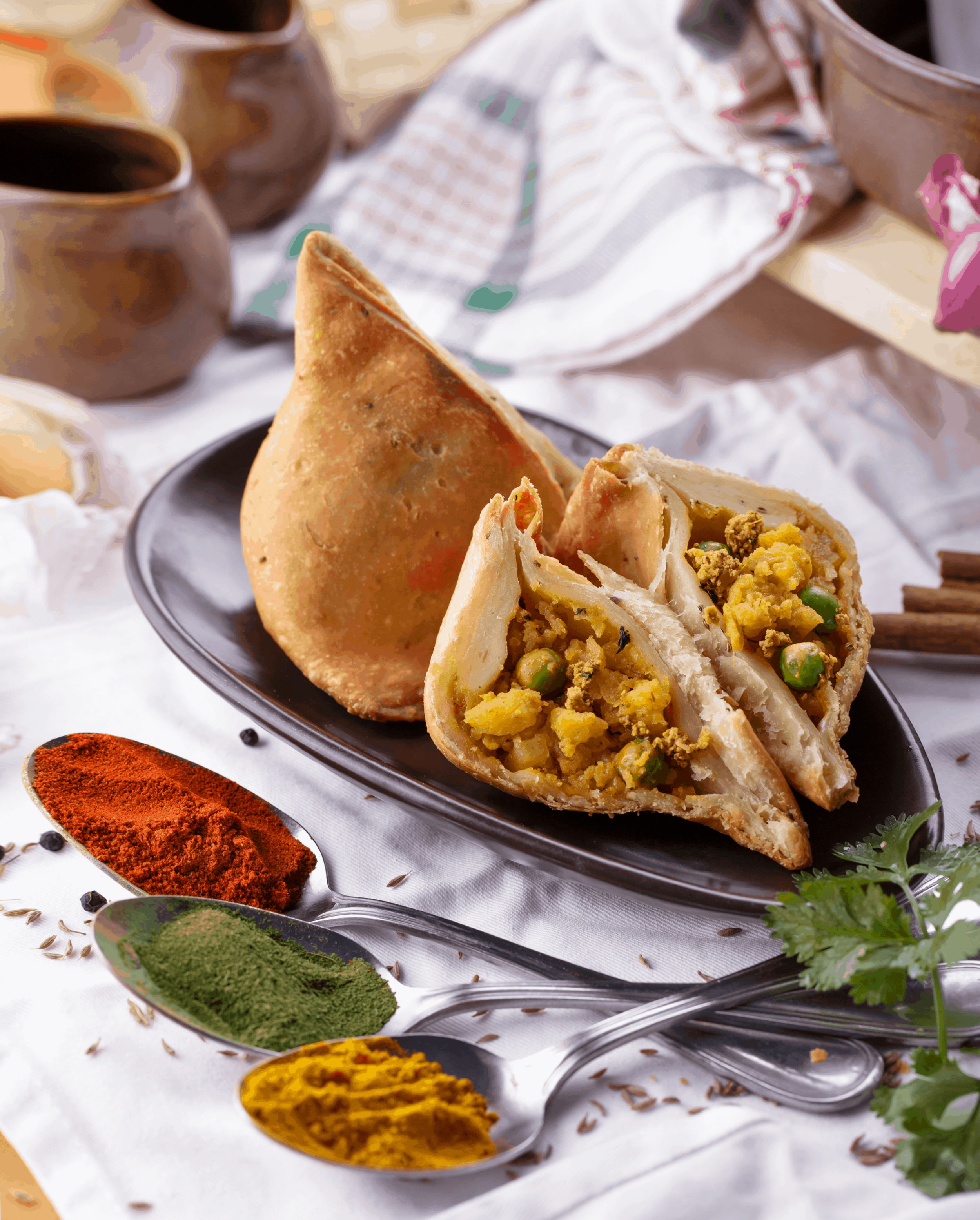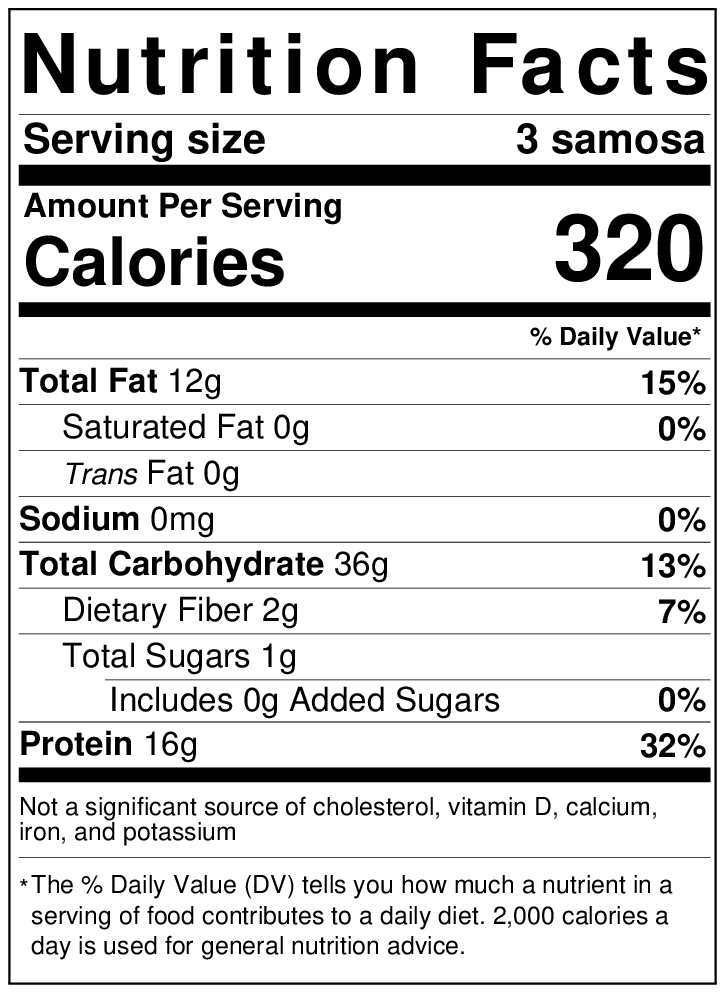Is Samosa Healthy? (3 Tips for Weight Loss)
If you have ever been to an Indian restaurant, you have probably ordered the famous samosa appetizer.
Depending on the religion or culture, samosas take on a variety of forms and can be shaped into a triangle, cone, or even a half moon-shape.
Wrapped within a crispy, flaky, and thin exterior, a samosa can be made with a variety of delicious fillings such as potato, pork, peas, or beef.
Even though samosas are undeniably delicious, you may be wondering, are they healthy?
When trying to lose weight, samosas are not the ideal food to consume regularly because they are packed with a lot of high-calorie and carbohydrate-dense ingredients. They are then deep-fried into oil which adds extra fat calories into this dish.
However, even though samosas are not the best weight-loss food, you can still enjoy samosas when trying to reach your goal physique!
In this article, we will be discussing three great tips that will help you understand more about the nutrition behind Samosa and how to enjoy this dish while still losing weight:
Tip 1: Understand the Ingredients in Samosas
Tip 2: Understand How Many Calories are in Samosas
Tip 3: Understand What Samosa is best for Weight Loss
Let’s get started!
Tip 1: Understand the Ingredients in Samosas
Samosas are made up of a variety of ingredients, depending on what you decide to do for the stuffing.
In this section, we will be discussing the ingredients that go into the typical samosa and why this is not the healthiest option.
All-purpose Flour
The fried samosa is made up of an outside skin made out of all-purpose flour. Usually formed into the shape of a triangle, all-purpose flour is a malleable and versatile ingredient used in a multitude of different pastries.
However, all-purpose flour contains a lot of simple carbohydrates which adds a lot of additional calories to your meal.
If you are trying to lose weight, it is important to reduce the amount of all-purpose flour you consume.
Another alternative is to replace your all-purpose flour with a lower calorie option such as coconut flour or almond flour.
Vegetable Oil
Samosas are deep-fried in oil and usually use either vegetable oil or cooking oil. Vegetable oil is commonly the most overlooked calorie counter.
However, it is important to realize that vegetable oil is extremely high in calories and can add a lot of additional fat to your meal.
For every tablespoon of vegetable oil, there are 120 calories which can add a lot of calories to your already calorically dense dish.
Samosas use a lot of vegetable oil which is a reason why it is so high in calories.
Potatoes
The most common Samosa has mashed potato filling and the soft texture perfectly complements the exterior crunch.
The potato gives the Samosa the main flavor and delicious bite that makes the dish a super satisfying savory dish.
Potatoes are another form of carbohydrate but are definitely one of the best carbohydrate sources out of the many that are available.
The reason why potatoes are a good carbohydrate source is because they make you really full and energized throughout the day.
However, eating too many potatoes can easily put you in a calorie surplus so it is important to portion size out your carb sources.
Vegetables
Finally, samosas often contain bits of vegetables like peas, onions, or even cauliflower.
Vegetables are a great low-calorie ingredient to add to any of your meals throughout the day.
It is vital to include vegetables into your diet when you are trying to lose weight because vegetables are filled with fiber and make you feel full and energized throughout the day.
Now that you understand the general ingredients that go into a Samosa, let’s talk about the nutritional information of the typical Samosa.
Tip 2: Understand How Many Calories are in Samosas
A Samosa is usually a little bit larger in bite-size and is easily a snack-able appetizer.
However, each individual Samosa is not necessarily the best food to frequently consume when you are trying to lose weight.
One serving of Samosas, which is around 3 pastries, is 400 calories with 7 grams of fat, 78 grams of carbohydrates, and 9 grams of protein.
As you can see, a Samosa is not the healthiest dish because it is really high in carbohydrates and calories, with very little protein.
We do not want to over-consume carbohydrates because carbohydrates often do not give us the same satiating effect that protein does.
This does not mean you should completely eliminate carbohydrate sources from your diet, but to make sure you are not over-consuming up to the point where you are in a calorie surplus.
The most important thing to remember is that the only way to lose weight is to be in a calorie deficit or consume less than your Total Daily Energy Expenditure (TDEE).
Your TDEE is essentially the number of calories that you burn throughout the day and is composed of the calories you burn at rest (when you’re just sitting there and not doing anything),
calories you burn when doing any physical activity (i.e. walking, running, sports, washing dishes), and calories you burn when you are eating and digesting food.
You may now be wondering, how do you figure out your TDEE? This is very simple!
All you have to do is go onto any credible fitness website, like Bodybuilding.com or NASM, and find their calorie calculator.
By putting in your sex, height, weight, and activity level, this calculator can help you generate an approximate number that is your TDEE.
Once you know your TDEE, to be in a calorie deficit, aim to eat around 300-500 calories less than your TDEE every single day.
Although you may not see results in the first couple of days, or maybe even the first week, it’s essential to trust the process and stay consistent.
Weigh yourself every single day, at the same time to get the most accurate results.
My favorite way to track how many calories I am eating every day is by using MyFitnessPal, which allows you to easily input your food into a journal and help you calculate how many calories you are eating throughout the day.
Remember that everyone’s body is unique, and the TDEE calculator is simply an estimate.
If you still do not see any results within around two weeks, try lowering your calorie intake by around 150-250 calories and observe the results.
Drink plenty of water throughout the process, and don’t forget to stay patient and consistent.
The Asian Weight Loss Cookbook
The 15 Fat Burning Meals Cookbook features our favorite recipes that you can use to get closer to your fitness goals.
Whether your goal is to lose 20 pounds or to stay healthier overall, this cookbook will guide you through it quickly and effectively.
Become your own personal trainer with the guidance of this book and make this the year you achieve your insurmountable fitness goals.
Tip 3: Understand What Samosa is Best for Weight Loss
Now that you understand the basic nutritional information of the most common potato-filled Samosa, in this section, we will discuss three alternative Samosas that are delicious and also a healthier and better option.
Ranking from the worst to the best, we will be covering which Samosas you should include in your diet when you are trying to lose weight.
Beef and Potato Samosas
Popular in Bangladesh and Pakistan, Beef and Potato Samosas are made of a combination of minced meat and potatoes that tend to have a little bit of spice.
One serving of Beef and Potato-filled Samosas is around 440 calories with 18 grams of fat, 49 grams of carbohydrates, and 21 grams of protein.
Beef and Potato-filled Samosas are a bit higher in fat from the beef but is lower in carbohydrates compared to the Potato Samosas.
Chicken Samosas
Mixed with ginger, garlic, and cumin, the chicken filling in the chicken samosas are bursting with unique and savory flavors.
Fried with mustard oil, chicken-filled samosas are some of the most popular versions of this delicious appetizer.
One serving of Chicken-filled Samosas is around 320 calories with 12 grams of fat, 36 grams of carbohydrates, and 16 grams of protein.
As you can see, Chicken-filled Samosas is a great low-calorie option that is much lower in carbohydrates and higher in protein from the chicken.
Spicy Pork Samosas
Finally, the healthiest samosa out of the three we just discussed is the spicy pork samosas.
Made with pull-porked mixed with cilantro, chili flakes, and cumin, this delicious and savory samosa is an excellent option.
One serving of Spicy Pork Samosas is around 350 calories with 11 grams of fat, 32 grams of carbohydrates, and 32 grams of protein. (6 g sugar, 4 g of fiber)
This is the best option out of the three meat Samosas that we discussed because it is very high in protein and relatively lower in calories.
With a decent amount of fat and an adequate amount of carbohydrates, Pork Samosas is a pretty good dish to consume when you are trying to lose weight.
However, spicy pork samosas often are paired with a high-calorie dipping sauce, so be sure to regulate how much dipping sauce you are using because this can add a lot of extra calories to your meal.
Conclusion
Remember, although nutrition is a huge factor that influences weight loss, it is important to pair this journey with exercise as well.
Especially strength training. Several years of research on the benefits of weight training have shown that individuals that do some sort of consistent resistance training at least 3-5 times a week have shown not only a great amount of weight loss but are also able to keep the weight off!
The secret to this phenomena is that strength training leads to a build-up of muscle.
Not only does your body recomposition into a more fitting and athletic-looking aesthetic, but having more muscle also increases your resting metabolic rate which essentially means you burn more calories at rest!
Now that we know the importance of muscle we need to make sure we stay on track with our workouts.
Consistency and longevity are the two key factors when building muscle so there will be some commitment involved.
We understand that not everyone has access to a gym membership or feels comfortable starting off in such an intimidating environment.
Although I would strongly recommend that everyone should get a gym membership, don’t worry we got your back!
You can either go to the gym or build one for yourself. It really just comes down to 3 pieces of equipment that you need to do most workouts. These three are the workout bench, dumbbells, and gym flooring.
Check out our recommended gear page to see our best picks for these pieces of equipment here.
https://www.aspirefitnesswalnut.com/home-workout-equipment
If a home gym is not for you then getting a membership somewhere works too. As long as you are starting your muscle-building journey, we’re happy!
RECENT POSTS
PHILLIP PAK
Phillip Pak is a fitness expert who has been training clients for 6 years. Throughout his fitness journey, Phill has done it all when it comes to diet and nutrition. He is now the owner of Aspire Fitness Walnut where his main goal is to help those who are seeking to find the best version of themselves. Phillip is also a NASM Certified Nutrition Coach (CNC) and a NASM Certified Personal Trainer (CPT).
















